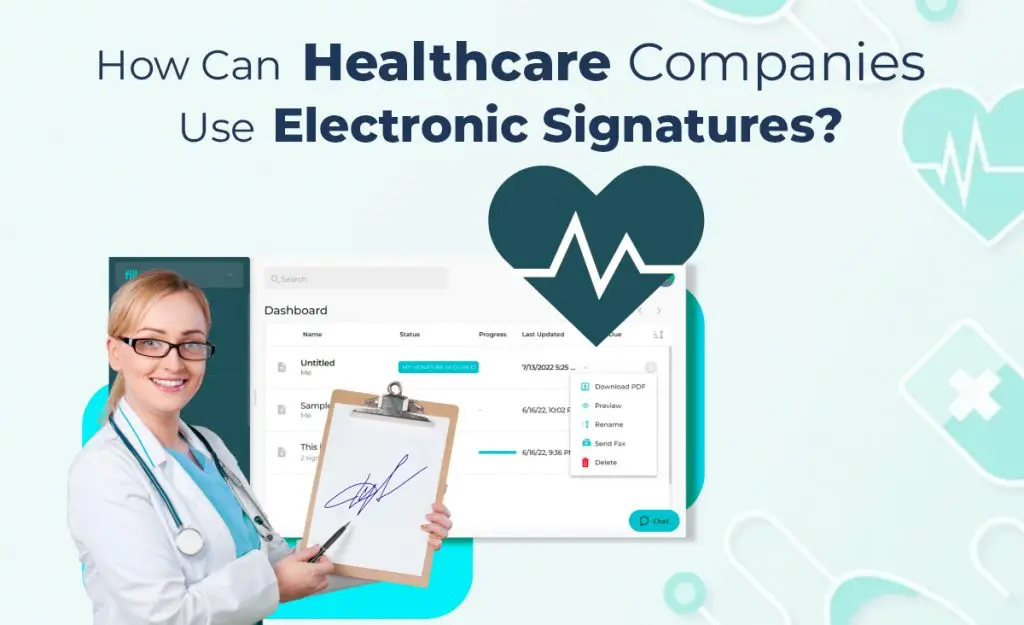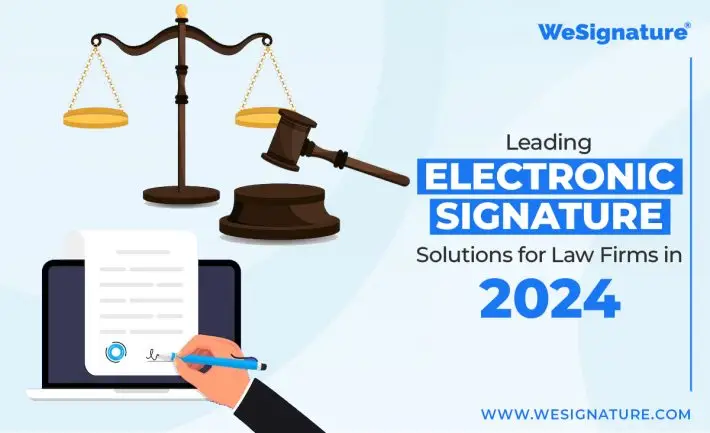How Can Healthcare Companies Use Electronic Signatures?

In the modern world, the healthcare industry continues to evolve and adapt to new technologies to improve patient care, simplify administrative processes, and increase overall efficiency. One of the most important advances that has had a significant impact on healthcare operations is the implementation of Electronic Signatures for Healthcare Companies. Electronic signatures offer many benefits, from reducing paperwork and increasing security to improving the patient experience. In this blog, we will explore various ways in which healthcare companies can leverage the power of e-signatures to their advantage.
Understanding Electronic Signatures For Healthcare Companies
Before we dive into specific use cases of electronic signatures in the healthcare sector, let’s clarify what electronic signatures are and how they work.
An electronic signature is a digital representation of a person’s handwritten signature. This can be as simple as using more advanced methods such as typing your name into an electronic document or drawing your signature on a touch screen. Electronic signatures are legally binding in many countries, including the United States, thanks to laws such as the Electronic Signatures for Healthcare Companies in Global and National Commerce (ESIN) Act and the Uniform Electronic Transactions Act (UETA).
Electronic signatures are highly secure and provide a tamper-proof seal on the document. They provide a level of trust and authenticity that paper-based signatures cannot match. When it comes to healthcare, trust, and security are paramount, as healthcare organizations handle sensitive patient data and important documents.
Now, let’s see how healthcare companies can make the most of e-signatures.
Streamline administrative tasks
Patient consent forms and agreements: One of the most common use cases of electronic signatures in healthcare is obtaining patient consent. Patients are often asked to sign various forms, such as consent to medical procedures, treatment plans, or release of health information. By using electronic signatures, healthcare organizations can simplify processes and reduce administrative burdens. Patients can easily sign documents on a tablet, mobile device, or computer at check-in, and these signed documents are stored securely electronically for future reference.
Insurance claims and billing: E-signatures can speed up the billing process by allowing patients to sign insurance claims and invoices electronically. This speeds up the reimbursement process and reduces the risk of errors because digital documents are easier to access and search.
Employee onboarding and HR documentation: Electronic signatures aren’t just for patient-related documentation. Healthcare companies can also use it for internal purposes. HR departments can benefit from electronic signatures for employee orientation, contracts, and various personnel-related documents. This reduces the need for physical documents and facilitates record keeping.
Improve patient experience
Telemedicine and Remote Patient Care: With the rise of telemedicine, electronic signatures play an important role in remote healthcare delivery. Patients can sign consent forms, treatment plans, and other documents electronically before or during telehealth sessions. This increases patient comfort and ensures important documentation is available.
Prescription management: Electronic signatures can be used to simplify the prescription workflow. Doctors can sign and send prescriptions electronically to pharmacies, reducing the need for paper and fax prescriptions. Patients can also use electronic signatures to acknowledge receipt of prescriptions.
Patient Portal Access: Electronic signatures can be used to facilitate patient access to a secure online portal where they can view medical records, and test results, and communicate with healthcare providers. Consent forms for portal access can be signed electronically, allowing patients to access their information more quickly and conveniently.
Improve Compliance and Safety
HIPAA Compliance: The Health Insurance Portability and Accountability Act (HIPAA) mandates strict rules for handling protected health information (PHI). Electronic signatures can help healthcare organizations maintain HIPAA compliance by providing a secure and auditable way to sign and manage PHI-related documents.
Chain of Custody: Electronic signatures create a digital chain of custody, offering.
Save Time and Resources
Reduce paperwork: The amount of paperwork in the healthcare industry can be overwhelming. Electronic signatures can significantly reduce the need for paper documents, filing cabinets, and physical storage space. This not only saves money but also reduces the impact of paper use on the environment.
Faster Document Completion: Electronic signatures allow for faster document completion times. Documents can be signed and returned in minutes, compared to the delays associated with traditional paper-based signatures, which may require delivery by mail or an in-person visit.
Integration with Electronic Health Records (EHRs): Electronic signatures can integrate seamlessly with EHR systems, enabling electronic signatures on medical records, progress notes, and care plans. This integration improves the accessibility and organization of patient data.
Application of Electronic Signatures in Health Services
Now that we’ve looked at the different ways healthcare companies can use electronic signatures, let’s discuss the steps in implementing this technology:
Choose the right e-signature solution
Choosing the right e-signature solution is critical. It is tailored to your healthcare organization’s specific needs and compliance requirements. Look for a solution that provides strong security, audit trails, and compatibility with your existing software systems.
Train staff and patients
Appropriate training is required to ensure that staff and patients use electronic signatures effectively. Provide clear instructions and support to avoid confusion or resistance to new technology.
Develop clear policies and procedures
Establish clear policies and procedures for the use of electronic signatures, particularly in contexts involving sensitive patient data. Make sure everyone in your organization follows these guidelines to maintain compliance and security.
Trial and Pilot Programs
Consider running a pilot program to identify and resolve any issues or concerns before implementing e-signatures on a large scale. This approach allows you to improve processes and build trust in users.
Monitoring and Maintenance
Once electronic signatures are in use, the system must be continuously monitored and maintained. Regularly update software, review access logs, and ensure compliance standards are met.
Legal Framework
As mentioned previously, electronic signatures are legally binding, including in the United States. The ESIN Act and UETA provide the legal framework for electronic signatures in the U.S. However, it is important to note that there are special requirements and considerations for the healthcare industry due to regulations such as HIPAA. It is important to consult legal counsel and ensure that your e-signature procedures comply with healthcare and privacy laws.
Challenges and Worries
While e-signatures offer many benefits to healthcare companies, there are several challenges and concerns to overcome:
Patient Acceptance: Some patients may have concerns about the security and authenticity of electronic signatures. Ensuring that the process is clearly explained and shows its safety features can help build trust.
Data Security: As with any digital process, data security is a primary concern. Healthcare organizations must invest in strong cybersecurity measures to protect e-signature data.
Compliance: Healthcare companies need to be vigilant in complying with laws and regulations, especially HIPAA. Failure to do so may result in severe penalties.
Integration and Training: Successful implementation of electronic signature depends on integration with existing systems and thorough training for staff and patients. Inadequate integration or training can lead to inefficiencies and errors.
Conclusion
The integration of electronic signatures into the healthcare industry has the potential to revolutionize the operations of healthcare organizations. From simplifying administrative tasks and improving the patient experience to increasing compliance and reducing costs, e-signatures offer many benefits.
Healthcare companies looking to implement e-signatures should carefully consider their specific needs, select the right solution, and develop clear policies and procedures. Additionally, compliance with healthcare regulations and ensuring data security are non-negotiable priorities.
As the healthcare industry continues to embrace digital transformation, electronic signatures will become an important tool to improve efficiency and patient care. By leveraging this technology, healthcare companies can provide a better experience for patients, healthcare providers, and administrative staff.



